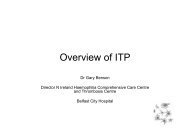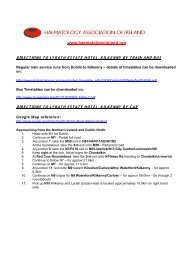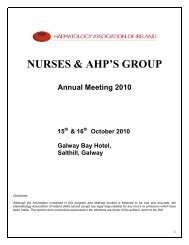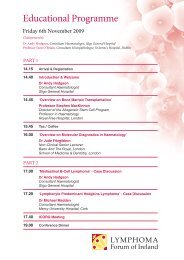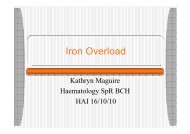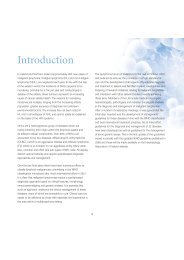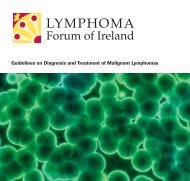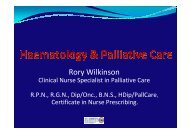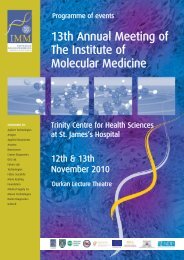Paroxysmal Nocturnal Haemoglobinuria (PNH) Dr Conal McConville ...
Paroxysmal Nocturnal Haemoglobinuria (PNH) Dr Conal McConville ...
Paroxysmal Nocturnal Haemoglobinuria (PNH) Dr Conal McConville ...
You also want an ePaper? Increase the reach of your titles
YUMPU automatically turns print PDFs into web optimized ePapers that Google loves.
<strong>Paroxysmal</strong> <strong>Nocturnal</strong> <strong>Haemoglobinuria</strong><br />
(<strong>PNH</strong>)<br />
<strong>Dr</strong> <strong>Conal</strong> <strong>McConville</strong><br />
SpR<br />
Belfast City Hospital<br />
August_12_2010Gbl
First Objective<br />
Describe the serious morbidities and mortality<br />
associated with chronic haemolysis in <strong>PNH</strong> patients<br />
August_12_2010Gbl<br />
2
<strong>Paroxysmal</strong> <strong>Nocturnal</strong> <strong>Haemoglobinuria</strong>:<br />
A Chronic Disabling and Life-Threatening Disease<br />
• Estimated 4,000 –<br />
6,000 patients in U.S. 1<br />
• 5 year mortality: 35% 2<br />
• Diagnosed at all<br />
Ages – Median age<br />
early 30’s 3,4<br />
• Quality of life<br />
diminished 5<br />
• Progressive disease 2-4<br />
Patients Surviving (%)<br />
100<br />
80<br />
60<br />
40<br />
20<br />
0<br />
Actuarial Survival From the Time of<br />
Diagnosis in 80 Patients With <strong>PNH</strong> 2<br />
0 5 10 15 20 25<br />
Years After Diagnosis<br />
Age- and sex-<br />
matched controls<br />
The expected survival of an age- and sex-matched control group is shown for comparison<br />
(Hillmen et al 1995). In a patient population where ½ the patients have
<strong>Paroxysmal</strong> <strong>Nocturnal</strong> <strong>Haemoglobinuria</strong><br />
• Firstly, a few facts:<br />
• It’s s not paroxysmal<br />
– Even in the absence of symptoms, destructive<br />
progression of haemolysis is ongoing<br />
• It’s s not nocturnal<br />
– Haemolysis in <strong>PNH</strong> is subtle and constant,<br />
24 hours a day<br />
• <strong>Haemoglobinuria</strong> is a less commonly seen<br />
complication<br />
– ¾ patients present without haemoglobinuria 1<br />
1. International <strong>PNH</strong> Interest Group. Blood. 2005;106:3699-3709.<br />
August_12_2010Gbl<br />
4
The Defect in <strong>PNH</strong><br />
The Somatic Mutation of the PIG A gene prevents<br />
all GPI anchored proteins from binding to cell surface<br />
CD59<br />
• Forms a defensive shield for RBCs<br />
from complement-mediated mediated lysis<br />
• Inhibits the assembly of the<br />
membrane attack complex<br />
CD55<br />
• Prevents formation and augments<br />
instability of the C3 convertases,<br />
attenuating the complement cascade<br />
CD59<br />
GPI-anchor<br />
CD55<br />
1. Adapted from: Johnson RJ et al. J Clin Pathol: Mol Pathol. 2002;55:145-152. 2. Brodsky R. <strong>Paroxysmal</strong> <strong>Nocturnal</strong> <strong>Haemoglobinuria</strong>. In: Hematology - Basic<br />
Principles and Practices. 4th ed. R Hoffman; EJ Benz; S Shattil et al, eds. Philadelphia, PA: Elsevier Churchill Livingstone; 2005; p. 419-427.<br />
August_12_2010Gbl<br />
5
Historically Viewed as a Hemolytic Anemia<br />
Normal red blood cells<br />
are protected from<br />
complement attack by<br />
a shield of terminal<br />
complement inhibitors<br />
Without this protective<br />
complement inhibitor<br />
shield, <strong>PNH</strong> red blood<br />
cells are destroyed<br />
Complement<br />
Activation<br />
Intact RBC<br />
Reduced Free Haemoglobin<br />
Red Cell Mass<br />
Anaemia<br />
1. International <strong>PNH</strong> Interest Group. Blood. 2005;106:3699-3709. 2. Brodsky R <strong>Paroxysmal</strong> <strong>Nocturnal</strong> <strong>Haemoglobinuria</strong>. In: Hematology - Basic Principles<br />
and Practices. 4th ed. R Hoffman; EJ Benz; S Shattil et al, eds. Philadelphia, PA: Elsevier Churchill Livingstone; 2005; p. 419-427. 3. Rother RP et al. JAMA.<br />
2005;293:1653-1662. 4. Socie G et al. Lancet. 1996;348:573-577. 5. Hill A et al. Br J Haematol. 2007;137:181-92.<br />
August_12_2010Gbl<br />
6
<strong>PNH</strong> is a Progressive Disease of<br />
Chronic Haemolysis<br />
Normal red blood cells<br />
Without this protective<br />
Thrombosis<br />
are protected from<br />
complement inhibitor<br />
complement attack by<br />
shield, <strong>PNH</strong> red blood<br />
a shield of terminal<br />
cells are destroyed<br />
Renal Failure<br />
complement inhibitors<br />
Pulmonary Hypertension<br />
Significant<br />
Impact on<br />
Survival<br />
Complement<br />
Activation<br />
Abdominal Pain<br />
Dyspnoea<br />
Intact RBC<br />
Free Haemoglobin<br />
Dysphagia<br />
Fatigue<br />
Significant<br />
Impact on<br />
Morbidity<br />
<strong>Haemoglobinuria</strong><br />
Anaemia<br />
Erectile Dysfunction<br />
1. International <strong>PNH</strong> Interest Group. Blood. 2005;106:3699-3709. 2. Brodsky R <strong>Paroxysmal</strong> <strong>Nocturnal</strong> <strong>Haemoglobinuria</strong>. In: Hematology - Basic Principles<br />
and Practices. 4th ed. R Hoffman; EJ Benz; S Shattil et al, eds. Philadelphia, PA: Elsevier Churchill Livingstone; 2005; p. 419-427. 3. Rother RP et al. JAMA.<br />
2005;293:1653-1662. 4. Socie G et al. Lancet. 1996;348:573-577. 5. Hill A et al. Br J Haematol. 2007;137:181-92. 6. Lee JW et al. Hematologica 2010. 95<br />
(s2): Abstract #505 and 506. 7. Hill A et al. Br J Haematol. 2010; May;149(3):414-25. 8. Hillmen P et al. Am. J. Hematol. 2010; 85:553–559.<br />
August_12_2010Gbl<br />
7
Current Understanding of <strong>PNH</strong>:<br />
Chronic Haemolysis is the Underlying Cause of<br />
Progressive Morbidities and Mortality of <strong>PNH</strong><br />
Thrombosis<br />
Venous<br />
Arterial<br />
• PE/DVT<br />
• Stroke/TIA<br />
• Cerebral<br />
• MI<br />
• Dermal<br />
• Hepatic/Portal<br />
• Abdominal ischemia<br />
Fatigue / Impaired<br />
Quality of Life<br />
• Abdominal pain<br />
• Dysphagia<br />
• Poor physical functioning<br />
• Erectile dysfunction<br />
Chronic Kidney Disease<br />
• Renal insufficiency<br />
• Dialysis<br />
• Hypertension<br />
End Organ Damage<br />
• Brain<br />
• Liver<br />
• GI<br />
Pulmonary Hypertension<br />
• Dyspnoea<br />
• Cardiac Dysfunction<br />
Anaemia<br />
• Transfusions<br />
• Haemosiderosis<br />
1. International <strong>PNH</strong> Interest Group. Blood. 2005;106:3699-3709. 2. Brodsky R. <strong>Paroxysmal</strong> <strong>Nocturnal</strong> <strong>Haemoglobinuria</strong>. In: Hematology - Basic Principles<br />
and Practices. 4th ed. R Hoffman; EJ Benz;S Shattil et al, eds. Philadelphia, PA: Elsevier Churchill Livingstone; 2005; p. 419-427. 3. Hillmen P et al. N Engl J<br />
Med. 1995;333:1253-1258. 4. Rosse W et al. Hematology (Am Soc Hematol Educ Program). 2004:48-62. 5. Rother R et al. JAMA. 2005;293:1653-1662. 6.<br />
Socie G et al. Lancet. 1996;348:573-577. 7. Hill A et al. Br J Haematol. 2007;137:181-92. 8. Lee JW et al. Hematologica 2010. 95 (s2): Abstract #505 and<br />
506. 9. Hill A et al. Br J Haematol. 2010; May;149(3):414-25. 10. Hillmen P et al. Am. J. Hematol. 2010; 85:553–559.<br />
August_12_2010Gbl<br />
8
Thrombosis<br />
Chronic Kidney Disease<br />
Fatigue / Impaired QOL<br />
Pulmonary Hypertension<br />
End Organ Damage<br />
Anemia<br />
Chronic Haemolysis is the Underlying Cause of<br />
Progressive Morbidities and Mortality of <strong>PNH</strong><br />
Thrombosis<br />
Venous<br />
Arterial<br />
• PE/DVT<br />
• Stroke/TIA<br />
• Cerebral<br />
• MI<br />
• Dermal<br />
• Hepatic/Portal<br />
• Abdominal ischemia<br />
Fatigue / Impaired<br />
Quality of Life<br />
• Abdominal pain<br />
• Dysphagia<br />
• Poor physical functioning<br />
• Erectile dysfunction<br />
Chronic Kidney Disease<br />
• Renal insufficiency<br />
• Dialysis<br />
• Hypertension<br />
End Organ Damage<br />
• Brain<br />
• Liver<br />
• GI<br />
Pulmonary Hypertension<br />
• Dyspnoea<br />
• Cardiac Dysfunction<br />
Anaemia<br />
• Transfusions<br />
• Haemosiderosis<br />
1. International <strong>PNH</strong> Interest Group. Blood. 2005;106:3699-3709. 2. Brodsky R. <strong>Paroxysmal</strong> <strong>Nocturnal</strong> <strong>Haemoglobinuria</strong>. In: Hematology - Basic Principles<br />
and Practices. 4th ed. R Hoffman; EJ Benz;S Shattil et al, eds. Philadelphia, PA: Elsevier Churchill Livingstone; 2005; p. 419-427. 3. Hillmen P et al. N Engl J<br />
Med. 1995;333:1253-1258. 4. Rosse W et al. Hematology (Am Soc Hematol Educ Program). 2004:48-62. 5. Rother R et al. JAMA. 2005;293:1653-1662. 6.<br />
Socie G et al. Lancet. 1996;348:573-577. 7. Hill A et al. Br J Haematol. 2007;137:181-92. 8. Lee JW et al. Hematologica 2010. 95 (s2): Abstract #505 and<br />
506. 9. Hill A et al. Br J Haematol. 2010; May;149(3):414-25. 10. Hillmen P et al. Am. J. Hematol. 2010; 85:553–559.<br />
August_12_2010Gbl<br />
9
Thrombosis<br />
Chronic Kidney Disease<br />
Fatigue / Impaired QOL<br />
Thrombosis in <strong>PNH</strong><br />
Pulmonary Hypertension<br />
• Is the leading cause of death<br />
• Occurs in typical and atypical site<br />
• All patients with <strong>PNH</strong> are at risk for<br />
thrombosis<br />
August_12_2010Gbl<br />
10
Thrombosis<br />
Chronic Kidney Disease<br />
Fatigue / Impaired QOL<br />
Pulmonary Hypertension<br />
Thrombosis in <strong>PNH</strong>:<br />
Common and Frequent Cause of Death<br />
• 40% of patients experience clinical thrombotic events 1<br />
• Leading cause of death 2<br />
– Accounts for 40–67% of deaths 1<br />
– First thrombotic event can be fatal 1,3<br />
– Median time to TE was 2.1-2.3 2.3 years from diagnosis 4<br />
– First TE increases risk for death 5 to 10-fold<br />
1<br />
1. Hillmen et al. Blood 2007; 110: 4123-4128. 2. International <strong>PNH</strong> Group et al. Blood. 2005;106(12):3699-3709. 3. Audebert HJ et al. J Neurol.<br />
2005;252:1379-1386. 4. De Latour. Blood. 2008; 112:3099-3106.<br />
August_12_2010Gbl<br />
11
Thrombosis<br />
Chronic Kidney Disease<br />
Fatigue / Impaired QOL<br />
Pulmonary Hypertension<br />
Does transfusion history or clone size impact the<br />
risk for thrombosis?<br />
August_12_2010Gbl<br />
12
Thrombosis<br />
Chronic Kidney Disease<br />
Fatigue / Impaired QOL<br />
Pulmonary Hypertension<br />
Evidence of Thrombosis in<br />
Never-Transfused <strong>PNH</strong> Patients*<br />
Parameter<br />
% of Patients<br />
Evidence of Thromboembolism (n=43) 28%<br />
TE events per 100 patient years 7.85<br />
TE rate in patients with <strong>PNH</strong> clone ≤50% (n=8) 33%<br />
TE rate in patients with <strong>PNH</strong> clone >50% (n=24) 30%<br />
15% of this patient cohort had LDH levels
Thrombosis<br />
Chronic Kidney Disease<br />
Fatigue / Impaired QOL<br />
Thrombosis in <strong>PNH</strong><br />
Pulmonary Hypertension<br />
• 40-67% mortality in <strong>PNH</strong> results from thrombosis 1<br />
– Thrombosis is the leading cause of death in <strong>PNH</strong> 2<br />
– First TE increases risk for death 5 to 10-fold 1<br />
• DVT or PE most common clinical presentation 1<br />
• Arterial thromboses are also common 3<br />
– 39% of TE events occur at arterial sites<br />
• Clinical thrombosis evident in all <strong>PNH</strong> patients: 1<br />
– Minimal haemolysis<br />
– No transfusion history<br />
– Smaller clone size 3<br />
1. Hillmen P et al. Blood. 2007;110:12:4123-4128. 2. International <strong>PNH</strong> Group et al. Blood. 2005;106(12):3699-3709. 3. Lee JW et al. Hematologica 2010. 95<br />
(s2): Abstract #506. 4. Hall C et al. Blood. 2003;102:3587-3591.<br />
August_12_2010Gbl<br />
14
Thrombosis<br />
Chronic Kidney Disease<br />
Fatigue / Impaired QOL<br />
Pulmonary Hypertension<br />
39% of TE Events Occur at Arterial Sites<br />
Renal vein<br />
6%<br />
Dermal<br />
2%<br />
Gangrene<br />
2%<br />
Cerebral venous<br />
occlusion<br />
2%<br />
RUL infarction*<br />
2%<br />
Hepatic portal<br />
8%<br />
PE<br />
10%<br />
Arterial<br />
39%<br />
Cerebral arterial occlusion<br />
14%<br />
Coronary arterial<br />
occlusion<br />
13%<br />
Mesenteric/visceral<br />
12%<br />
DVT<br />
17%<br />
Mesenteric/visceral<br />
artery<br />
10%<br />
Retinal artery<br />
obstruction<br />
2%<br />
*RUL; right upper lobe<br />
Lee JW et al. Hematologica 2010. 95 (s2): Abstract #505.<br />
Arterial TE events were common in a large,<br />
retrospective analysis<br />
South Korean National Registry<br />
August_12_2010Gbl<br />
15
Thrombosis<br />
Chronic Kidney Disease<br />
Fatigue / Impaired QOL<br />
Kidney Disease<br />
Pulmonary Hypertension<br />
• 8-18% mortality in <strong>PNH</strong> results from renal failure 1<br />
• Kidney disease in <strong>PNH</strong> is caused by haemolysis 2<br />
• 64% of patients with <strong>PNH</strong> exhibit chronic kidney disease at<br />
any one time 3<br />
– Renal insufficiency prevalence in <strong>PNH</strong> is 6.6 times<br />
higher than reported for the general population 4<br />
• Kidney disease is underappreciated in <strong>PNH</strong> 3<br />
1. Nishimura JI et al. Medicine. 2004;83:193-207. 2. Clark DA et al. Blood. 1981 Jan;57(1):83-9. 3. Hillmen P et al. Am. J. Hematol. 2010; 85:553–559.<br />
4. Stevens LA et al. N Engl J Med. 2006;354:2473-83.<br />
August_12_2010Gbl<br />
16
Thrombosis<br />
Chronic Kidney Disease<br />
Fatigue / Impaired QOL<br />
Impact of <strong>PNH</strong> on Quality of Life<br />
Pulmonary Hypertension<br />
~75% of Patients Reported Symptoms as Moderate to Very Severe<br />
59% patients were transfusion-free free for at least 12 mo or had never been transfused<br />
76% were forced to modify their daily activities to manage their <strong>PNH</strong><br />
17% were unemployed due to <strong>PNH</strong><br />
*Moderate to severe; N=29.<br />
Meyers G et al. Blood. 2007;110 (11): Abstract 3683.<br />
August_12_2010Gbl<br />
17
Thrombosis<br />
Chronic Kidney Disease<br />
Fatigue / Impaired QOL<br />
Haemolysis Causes Fatigue<br />
Independent of Anemia<br />
Pulmonary Hypertension<br />
• Rosse (Hoffman-Haematology) 1<br />
– “Many patients note a feeling of fatigue that may be<br />
disabling during periods of haemoglobinuria.”<br />
– This is not related to haemoglobin level (anaemia), as it<br />
disappears when the haemoglobinuria stops.”<br />
• Brodsky (Hoffman-Haematology) 2<br />
– “<strong>PNH</strong> patients frequently complain of disabling fatigue<br />
that is often out of proportion to the degree of anaemia.”<br />
• Multivariate analysis indicates haemolysis drives fatigue in<br />
<strong>PNH</strong> – not anaemia 3<br />
1. Rosse W. <strong>Paroxysmal</strong> nocturnal haemoglobinuria In: R Hoffman; EJ Benz; SJ Shattil et al., eds. Hematology: Basic Principles and Practice. 3rd ed. New<br />
York: Churchill-Livingstone; 2000:331-342. 2. Brodsky RA. <strong>Paroxysmal</strong> nocturnal haemoglobinuria. In: R Hoffman; EJ Benz; SJ Shattil et al., eds. Hematology.<br />
Basic Principles and Practice. 4th ed. Philadelphia: Elsevier Churchill Livingstone; 2005:419-427. 3. Hill A et al. Haematologica. 2008;93(s1):359. Abstract<br />
0903 and Presentation at: European Hematology Association 15 th Annual Meeting; June 15 th , 2008; Copenhagen, Denmark.<br />
August_12_2010Gbl<br />
18
Thrombosis<br />
Chronic Kidney Disease<br />
Fatigue / Impaired QOL<br />
Pulmonary Hypertension<br />
Pain is a Common Symptom in <strong>PNH</strong><br />
Patients<br />
Pain,<br />
No treatment<br />
Medical Intervention<br />
Pain,<br />
Treatment<br />
Opioids<br />
Other<br />
No pain<br />
NSAID<br />
(n=286)<br />
Almost 3 out of 5 (58%) patients reported significant pain<br />
47% of patients with pain required medical intervention<br />
South Korean National Registry<br />
Lee JW et al. Hematologica 2010. 95 (s2): Abstract #506.<br />
August_12_2010Gbl<br />
19
Thrombosis<br />
Chronic Kidney Disease<br />
Fatigue / Impaired QOL<br />
Pulmonary Hypertension<br />
Fatigue and Quality of Life Conclusions<br />
• 96% of patients report fatigue 1<br />
– Fatigue/QoL independent of anemia/transfusion requirements<br />
• 76% of patients with <strong>PNH</strong> have disruptions in daily<br />
activities 1<br />
– 17% of patients were unemployed due to <strong>PNH</strong><br />
• Fatigue, QoL and abdominal pain are linked by<br />
underlying haemolysis and the threat of ischemia and<br />
mortality 2<br />
– 66% of patients report shortness of breath<br />
– 57% of patients report abdominal pain<br />
• 2.2-fold increased risk of mortality<br />
• 3.6-fold increased risk of developing TE<br />
• <strong>PNH</strong> symptoms are independent of clone size 3<br />
1. Meyers G et al. Blood. 2007;110(11):Abstract 3683. 2. Lee JW et al. Hematologica 2010. 95 (s2): Abstract #506. 3. Urbano-Ispizua A et<br />
al. Hematologica 2010. 95 (s2): Abstract #1022.<br />
August_12_2010Gbl<br />
20
Thrombosis<br />
Chronic Kidney Disease<br />
Fatigue / / Impaired QOL<br />
Is Dyspnoea in <strong>PNH</strong> Linked to Pulmonary<br />
Hypertension?<br />
• 66% of <strong>PNH</strong> patients report dyspnoea 1<br />
Pulmonary Hypertension<br />
• Haemolysis results in cell-free haemoglobin and NO<br />
consumption leading to pulmonary hypertension 2,3<br />
1. Meyers G et al. Blood. 2007;110(11):Abstract 3683. 2. Rother R. et al. JAMA. 2005; 293: 1653-1662. 3. Hill A et al. Br J Haematol. 2010; May;149(3):414-25.<br />
August_12_2010Gbl<br />
21
Thrombosis<br />
Chronic Kidney Disease<br />
Fatigue / / Impaired QOL<br />
Evidence of<br />
Pulmonary Hypertension in <strong>PNH</strong><br />
Pulmonary Hypertension<br />
Study 1:<br />
47% of patients (34/73) had elevated NT-proBNP<br />
≥160<br />
pg/ml, indicating PHT in these patients 1<br />
Study 2:<br />
43% of haemolytic <strong>PNH</strong> patients (12/28) had mild to<br />
moderate PHT and 7% (2/28) had severe PHT, measured<br />
by doppler echocardiography 2<br />
Study 3:<br />
80% of <strong>PNH</strong> patients with elevated BNP levels had<br />
reduced right ventricular ejection fraction (RVEF) 3<br />
1. Hill A et al. Blood. 2008;112 (11):Abstract 486. 2. Hill et al. Br J Haematol. 2006;133 (suppl 1):119:Abstract 316. 3. Hill et al. Blood. 2006;108(11): Abstract 979.<br />
August_12_2010Gbl<br />
22
Common Symptoms of Haemolysis<br />
Signal the Underlying Threat of Catastrophic Consequences<br />
Dyspnoea<br />
Dysphagia<br />
Abdominal Pain<br />
Impaired QoL<br />
Fatigue<br />
<strong>Haemoglobinuria</strong><br />
Erectile Dysfunction<br />
Anaemia<br />
DVT<br />
Acute Renal Failure<br />
Hepatic Failure<br />
Chronic<br />
Kidney Disease<br />
Cardiac<br />
Dysfunction<br />
Stroke / TIA<br />
Pulmonary Hypertension<br />
Ischemic Bowel<br />
August_12_2010Gbl<br />
23
ESA=erythropoietin stimulating agents<br />
Historical Management of <strong>PNH</strong><br />
Palliative options do not impact progression and risk<br />
for severe morbidities and mortality 1<br />
• Transfusions<br />
– Risk of iron overload<br />
– Transient treatment of anaemia<br />
• Anticoagulants<br />
– Risk of haemorrhage<br />
– Ineffective in many patients 2<br />
• Red cell supplements<br />
– ESAs may expand clones and elevate haemolysis<br />
– Folic acid, iron, erythropoiesis-stimulating stimulating agents<br />
• Steroids/androgen hormones<br />
– No controlled clinical trials<br />
– AE’s<br />
1. International <strong>PNH</strong> Interest Group. Blood. 2005;106:3699-3709. 2. Hillmen P et al. Blood. 2007;110:4123-8.<br />
August_12_2010Gbl<br />
24
Historical Management of <strong>PNH</strong><br />
Bone Marrow Transplant<br />
BMT is associated with significant morbidity and mortality<br />
Haemolysis and thrombosis are risk factors for poor outcomes<br />
• In a recent retrospective study in France examining <strong>PNH</strong><br />
patients: 1<br />
– 54% had GVHD<br />
• In another study examining <strong>PNH</strong> patients (n=23 )2<br />
– 50% chronic GVHD; 42% acute GVHD<br />
• BMT has a significant impact on quality of life post<br />
transplant 3,4<br />
• Allogeneic BMT recommended for <strong>PNH</strong> patients with life-<br />
threatening cytopenias or possibly the rare patient with<br />
disabling haemolysis or thrombosis not controlled with<br />
existing therapy 5<br />
1. De Latour PF et al. Abstract #316. EBMT 2009. 2. Santarone S et al. Haematologica. 2010; Jun;95(6):983-8 . 3. Bieri S et al. Bone Marrow Transplantation.<br />
2008; 42: 819–827. 4. Fraser CJ et al. Blood. 2006;108: 2867-2873. 5. Brodsky RA. Blood. 2009 113: 6522-6527<br />
August_12_2010Gbl<br />
25
SOLIRIS ® ▼(eculizumab)<br />
• Soliris® is indicated for the treatment of patients with<br />
paroxysmal nocturnal haemoglobinuria. Evidence of<br />
clinical benefit of Soliris® in the treatment of patients<br />
with <strong>PNH</strong> is limited to patients with history of<br />
transfusions.<br />
August_12_2010Gbl<br />
26
SOLIRIS ® Blocks Terminal Complement<br />
Complement Cascade<br />
SOLIRIS®<br />
C3<br />
C3a<br />
•<br />
SOLIRIS® binds with high affinity to C5<br />
Proximal<br />
C3b<br />
•<br />
Terminal complement - C5a and C5b-9<br />
activity blocked<br />
C5<br />
C5a<br />
•<br />
Proximal functions of complement<br />
remain intact<br />
Terminal<br />
C5b<br />
C5b-9<br />
Cause of Haemolysis<br />
in <strong>PNH</strong><br />
•<br />
Weak anaphylatoxin<br />
•<br />
Immune complex clearance<br />
•<br />
Microbial opsonization<br />
1. Figueroa JE, Densen P. Clin Microbiol Rev. 1991;4(3):359-395. 2. Walport MJ. N Engl J Med. 2001;344(14):1058-66. 3. SOLIRIS® (eculizumab) [package insert]. Alexion Pharmaceuticals; 2009. 4. Rother RP et al. Nature<br />
Biotech. 2007;25(11):1256-64.<br />
August 12_10_2010Gbl<br />
27
Summary of Clinical Efficacy<br />
In clinical trials, SOLIRIS ® significantly reduced haemolysis 1<br />
the underlying cause of morbidity and mortality in <strong>PNH</strong><br />
• 86% sustained reduction in haemolysis as measured by LDH 2<br />
• 92% reduction in thrombotic events across all patient types 3<br />
• 94% reduction in thrombotic events in patients treated with<br />
anticoagulants 3<br />
• Patients treated with SOLIRIS experienced improvement in CKD and<br />
pulmonary hypertension 4,5<br />
• 78% clinically meaningful improvement in fatigue<br />
– Fatigue in <strong>PNH</strong> impacted by haemolysis<br />
– Significant improvement noted in pain and dyspnoea along with a<br />
broad range of QoL measures 5<br />
• 73% reduction in need for transfusions across all patient populations<br />
2<br />
1. SOLIRIS® (eculizumab) [package insert]. Alexion Pharmaceuticals; 2009. 2. Hillmen P et al. N Engl J Med. 2006;355:1233-43. 3. Hillmen P et al. Blood. 2007;110(12):4123-8. 4. Hillmen P et al. Am. J. Hematol. 2010; 85:553–559 5.<br />
Hill A, et al. BJH. doi:10.1111/j.1365-2141.2010 5. Socie G et al. Blood. 2007;110(11)::Abstract 3672.<br />
August 12_10_2010Gbl<br />
28
Adverse Reactions Reported in ≥ 5% of<br />
SOLIRIS ® Treated Patients in TRIUMPH<br />
SOLIRIS® (eculizumab) [package insert]. Alexion Pharmaceuticals; 2009.<br />
Patients, n (%)<br />
Reaction SOLIRIS ® (n = 43) Placebo (n = 44)<br />
Headache 19 (44) 12 (27)<br />
Nasopharyngitis 10 (23) 8 (18)<br />
Back pain 8 (19) 4 (9)<br />
Nausea 7 (16) 5 (11)<br />
Fatigue 5 (12) 1 (2)<br />
Cough 5 (12) 4 (9)<br />
Herpes simplex virus infections 3 (7) 0<br />
Sinusitis 3 (7) 0<br />
Respiratory tract infection 3 (7) 1 (2)<br />
Constipation 3 (7) 2 (5)<br />
Myalgia 3 (7) 1 (2)<br />
Pain in extremity 3 (7) 1 (2)<br />
Influenza-like illness 2 (5) 1 (2)<br />
August 12_10_2010Gbl<br />
29
Patient Safety Card<br />
• Patients should be informed<br />
that they will be provided with<br />
a Patient Safety Card<br />
• Patients should carry the card<br />
with them at all times<br />
• The card describes symptoms,<br />
which if experienced, should<br />
prompt the patient to seek<br />
immediate medical attention<br />
• Instruct patients to show the<br />
card to all health care<br />
providers involved in<br />
their care<br />
SOLIRIS® (eculizumab) [package insert]. Alexion Pharmaceuticals; 2009.<br />
August 12_10_2010Gbl<br />
30
August 12_10_2010Gbl<br />
Thank you<br />
Thank you<br />
31



